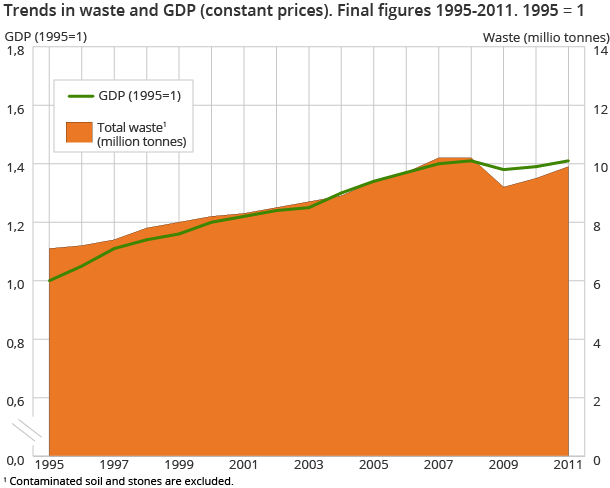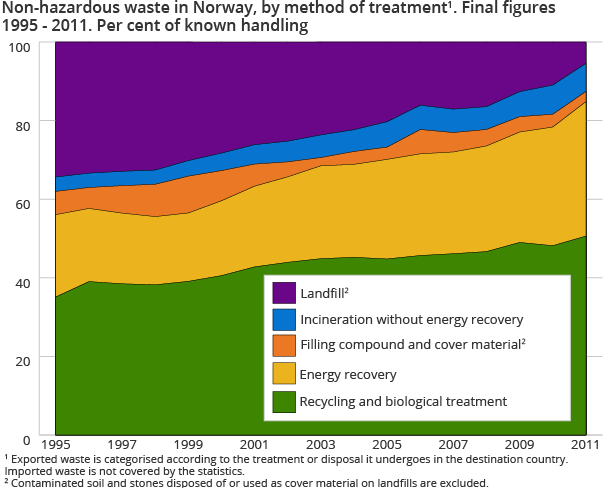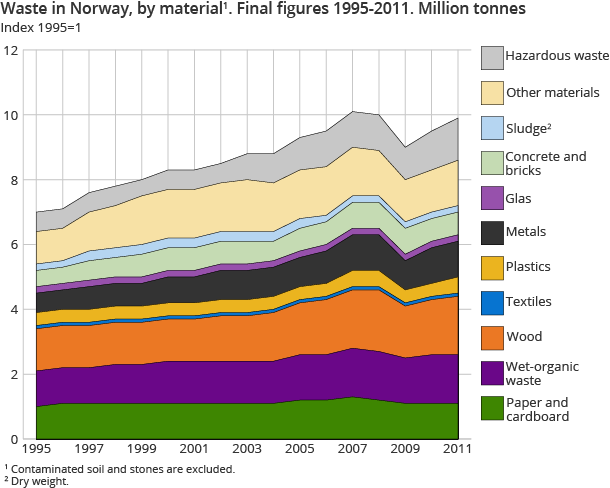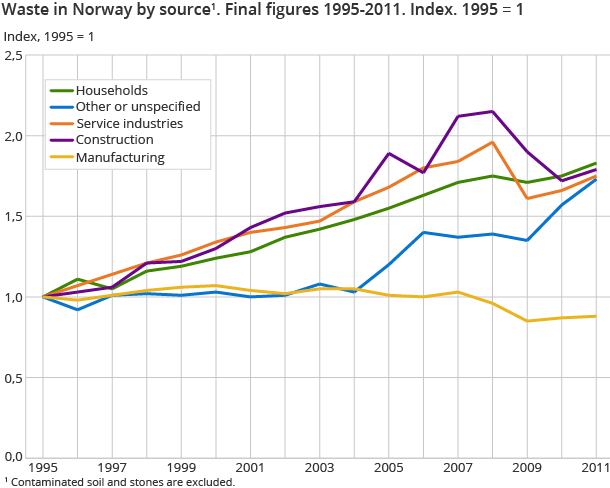Content
Published:
This is an archived release.
More waste is recovered
The total waste amount for Norway increased by 5 per cent from 2010 to 2011. In 2011, a total of 9.9 million tonnes of waste was generated. Waste recovery also continues to increase.
| 1000 tonnes | Share | Per cent | ||
|---|---|---|---|---|
| 2010 - 2011 | 2006 - 2011 | |||
| 2011 | ||||
| Material, total. Except contaminated soil | 9 890 | 100.0 | 4.6 | 2.0 |
| Paper,cardboard and pasteboard | 1 085 | 11.0 | -2.0 | -13.0 |
| Metals | 1 096 | 11.1 | 2.8 | 7.8 |
| Plastic | 478 | 4.8 | 8.9 | 8.1 |
| Glas | 214 | 2.2 | 2.4 | -4.9 |
| Wood waste | 1 815 | 18.4 | 9.3 | 9.8 |
| Textiles | 113 | 1.1 | -3.4 | -8.1 |
| Wetorganic waste | 1 452 | 14.7 | -2.7 | 1.3 |
| Concrete and bricks | 710 | 7.2 | 3.8 | 0.4 |
| Sludges | 227 | 2.3 | 11.3 | -8.5 |
| Other | 1 441 | 14.6 | 9.7 | -3.9 |
| Hazardous | 1 259 | 12.7 | 8.3 | 14.2 |
Waste amounts have been steadily increasing over the last few years, and we are now generating only 3 per cent less waste than in 2007, when the amounts peaked. At the same time, the value added measured by GDP (constant prices) has increased by 0.5 per cent since 2007, which means that more values has been added per tonne of generated waste.
More waste is recovered
While the amount of waste is increasing, the amount of waste that is sent for recovery is also increasing. In 2011, 46 per cent of non-hazardous waste undergoing known treatment was subject to material recovery, while 34 per cent was used in energy recovery. The total recovery of non-hazardous waste undergoing known treatment was 87 per cent in 2011; an increase from 82 per cent in 2010.
The increase in material recovery is mainly due to increased recovery efforts by the construction industry for waste fractions such as concrete, gypsum and asphalt. For further reading, see the article about waste from the building and demolition industry . Increased incineration of paper, plastics and wood, as well as mixed waste, is most likely the cause of the increase in energy recovery.
The amount of waste going to landfill is still dropping. In 2011, only 0.8 million tonnes of waste was deposited, which is only 41 per cent of the amount that went to landfill in 2007, when the waste amounts in Norway peaked. The main reason for this drop in landfilling is the ban on landfilling with biologically degradable waste from 1 July 2009. The main fraction of waste that is now deposited is hazardous waste .
Increase in sludge, decrease in textiles and wet-organic waste
The waste fractions with the largest increases from 2010 to 2011 were sludge followed by other materials, wood and hazardous waste, with increases of 12, 10, 9 and 8 per cent respectively. The largest increase, in absolute figures, was in wood waste, by 150 000 tonnes. Other materials increased by 130 000 tonnes and include large amounts of slag from the manufacturing industry and asphalt from the construction industry. The increase in hazardous waste is mainly from the oil extraction industry and from the waste handlers. For further reading, see the article on hazardous waste.
The waste fractions that decreased the most from 2010 to 2011 were textiles, wet-organic waste and paper and cardboard, with a decrease of 3, 3 and 2 per cent respectively. A decrease in the sorting of wet-organic waste is prominent in several different industries and this is explained in more detail in the article on waste from the service industry . The amount of paper waste has been steadily decreasing since the peak in 2007 and the amount of paper waste has decreased by 13 per cent compared to 3 per cent for the total waste amounts in this period. More use of electronic media is a plausible explanation for this decrease.
Increase in waste from the sewerage and waste management industry
The manufacturing industry is still the source of the largest amount of waste, with 2.7 million tonnes in 2011, followed by households and the construction and demolition industries. However, the amounts in these sources have seen no major change in recent years. The largest increase in waste amounts came in the sewerage and waste management industry, with an increase of 38 per cent since last year. The main source of this increase was hazardous waste. Also in the electricity, gas and water supply industry and the mining and quarrying industry there has been a significant increase of 18 and 17 per cent respectively from 2010 to 2011. Hazardous waste is again the largest source of the increase in the mining and quarrying industry. A large increase in oil-containing waste from the oil extraction industry is the main source.
While the waste amounts in the aforementioned industries increased, the agriculture, forestry and fishing field has seen a 3 per cent decrease in the last year. However, this is a field that normally produces small amounts of waste and the decrease has therefore little impact on the total waste amounts for Norway.
Masses for landfilling soaring
While ordinary waste sent for landfill has decreased in the last couple of years, the masses of soil, stones and gravel for landfilling have increased. In 2011, 1.5 million tonnes were sent to ordinary landfills, while 0.6 million tonnes were deposited on industrial landfills. The rest of the deposited masses were cover materials.
Waste and contaminated soil and stones in the waste accountsOpen and readClose
Waste in the waste accounts includes all waste, also hazardous waste, but excludes contaminated soil and stones. The waste is however counted only once. This means that residues from waste treatment, such as non-composted fractions from composting plants and sorting residues from sorting plants are excluded. However, slag and other residues from waste incineration are included, as these matters are highly transformed and thus have the character of being a new material. Contaminated soil and stones is explained in the separate article on waste treatment.
Contact
-
Camilla Skjerpen
E-mail: camilla.skjerpen@ssb.no
tel.: (+47) 48 22 72 14




